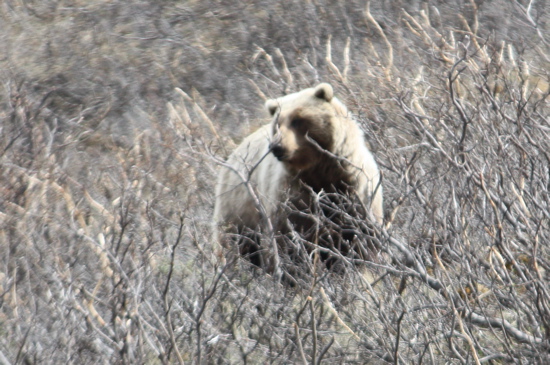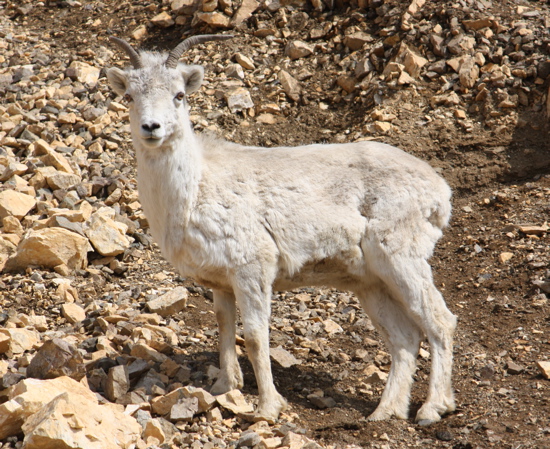
Alaskans call themselves “sourdoughs” in tribute to the prospectors who settled much of America’s last frontier in the late 19th century.
Among the miners’ most treasured staples in those days before powdered yeast became commonplace was a crock of sourdough starter to leaven their bread, biscuits and pancakes. The starter – a mixture of flour and water allowed to ferment with wild yeast in the air – was so central to their diets that they called anyone who survived a hard winter in the gold fields a “sourdough.”
So it seemed only fitting that I should bring a jar of starter with me on my camping tour of Alaska. What better way to start the day in the shadow of the rugged Alaskan Range than with a stack of sourdough pancakes swimming in maple syrup?
Even though we’re staying in a developed campground in Denali National Park, there’s no doubt that we’re on the fringe of a wilderness that has changed little since prospectors and trappers arrived in the heart of Alaska.
 A moose, all ungainly legs and protuberant nose, grazed on the fresh green tips of spruce trees not far from our campsite the other day. Red signs posted on all the trails warn that female moose are calving in the area, increasing the presence of hungry bears. At a campfire program, the ranger told of a moose tearing through the woods just as another program had ended a few days earlier. A grizzly was on its heels.
A moose, all ungainly legs and protuberant nose, grazed on the fresh green tips of spruce trees not far from our campsite the other day. Red signs posted on all the trails warn that female moose are calving in the area, increasing the presence of hungry bears. At a campfire program, the ranger told of a moose tearing through the woods just as another program had ended a few days earlier. A grizzly was on its heels.
 From our shuttle bus en route to Toklat, 53 miles into the center of the park, we spotted a pair of grizzlies, a couple of moose and more than a dozen Dall sheep – the animals whose threatened population inspired the creation of the park in 1917 as a game refuge. A fox, snowshoe hares, golden eagles and ptarmigan appeared, too.
From our shuttle bus en route to Toklat, 53 miles into the center of the park, we spotted a pair of grizzlies, a couple of moose and more than a dozen Dall sheep – the animals whose threatened population inspired the creation of the park in 1917 as a game refuge. A fox, snowshoe hares, golden eagles and ptarmigan appeared, too.
 What we didn’t see was Denali, the Athabaskan name for the mountain identified as Mt. McKinley on official maps. At 20,320 feet, it’s the highest mountain in North America, but it’s notoriously shy. Even when the sky is clear elsewhere, Denali wraps itself in mist and clouds. Rangers tell visitors that they only have a 20 percent chance of seeing the mountain.
What we didn’t see was Denali, the Athabaskan name for the mountain identified as Mt. McKinley on official maps. At 20,320 feet, it’s the highest mountain in North America, but it’s notoriously shy. Even when the sky is clear elsewhere, Denali wraps itself in mist and clouds. Rangers tell visitors that they only have a 20 percent chance of seeing the mountain.
To sustain us for a day of watching for the mountain to peek from behind its veils, I made pancakes with the starter I brought from home. I was worried about whether it would work since all sourdough lore emphasizes the importance of keeping your starter warm so it will be active enough to raise batter. But the pancakes came through even if Denali didn’t. (If you want to see the mysterious mountain on one of its good days, click here.)
Although temperatures dropped to 40 degrees overnight and our little camper is unheated, the starter bubbled away after it had been fed with more flour and water. Just before cooking, I stirred in milk, oil, an egg, a little sugar, and salt. The pancakes were picture perfect, light, tender and a little crisp around the edges.
The starter came from a friend, who had been nurturing it for some time. That’s one of the nice things about starters. Once you get them going, they need to be fed regularly and there’s always plenty to share. Take a cup of starter out for a loaf of bread or a batch of biscuits and stir in ½ cup of flour and ½ cup of water and it will replenish itself. I’ve even used my starter to make terrific sourdough cornbread straight out of an old “Joy of Cooking.”
A starter can be kept going indefinitely as long as you feed it, the flavor getting deeper and more tangy as the benign bacteria grow. I store mine in the refrigerator between baking bouts and have let it languish as long as three weeks between feedings. It hasn’t failed me yet.
If you don’t have a friend with starter to spare, or if you’ve let yours expire from neglect, don’t despair. It’s easy to make a new one. Even if it’s not quite as tangy as a mature starter, it will raise your baked goods just as well. In the past, I’ve used the recipe below with great results.
You don’t have to be an Alaskan to appreciate good sourdough.
Makes about 12 4-inch pancakes
1 cup sourdough starter
2½ cups flour
1½ cups warm water
½ cup milk
1 egg
2 tablespoons vegetable oil
2 tablespoons sugar
½ teaspoon salt
1 cup fresh berries, if desired
Butter for cooking
Maple syrup
The night before, mix starter with flour and warm water in a covered pot and let stand in a warm, protected place. The next morning, remove 1 cup of the batter and return to your sourdough jar. Add milk, egg, oil, sugar, and salt and mix lightly. At this point, you may stir in some fresh berries.
Heat frying pan until it’s hot enough to make water sprinkled on the surface dance around and sizzle. Add just enough butter to film the pan. After the butter melts, ladle about ½ cup of batter into the pan and cook until surface becomes dry and bubbles begin to form around the edge of the pancake. Flip and cook the second side until lightly browned on the bottom.
Serve with syrup.
Adapted from “Beyond Gorp,” by Yvonne Prater and Ruth Dyar Mendenhall, with Kerry I. Smith (The Mountaineers Books, 2005)
SOURDOUGH STARTER
1 cup 2 percent milk
3 tablespoons plain nonfat yogurt
1 cup organic bread flour
Place milk in a small, non-reactive pan and warm on low heat until it reaches 100 degrees on a food thermometer. Pour milk into a medium bowl or a 2-cup glass measure and stir in the yogurt. Cover with plastic wrap and set in the warmest place in your kitchen. About 80 degrees is just right.
Let the yogurt and milk mixture stand for about 24 hours until it’s quite thick. Stir in the flour, whisk with a fork, then cover again and return to the warm spot. Let mixture stand undisturbed until it’s full of bubbles and smells sour. That should take 2-5 days.
If a clear liquid settles on top of the starter, stir it back in. If the liquid is pink, throw the starter out – airborne pathogens have contaminated the starter. This doesn’t happen very often.
Once starter is bubbly and light, cover loosely and store in the refrigerator. It should be fed around once a week: Remove from the fridge and let it come to room temperature. Take out 1 cup of starter and discard or use in a recipe. Stir in ½ cup each of flour and warm water and let stand in a warm place until it begins to show bubbles on the surface.
Adapted from “Rustic European Breads from Your Bread Machine,” by Linda West Eckhardt and Diana Collingwood Butts (Doubleday, 1995).

This is beautiful storytelling. Thanks!
Wow, it’s 40 degrees at night and you’re camper is unheated? I know I’m a California girl cause that’s way too hard-core for me. Beautiful pictures Aleta. And I agree with mj, beautiful storytelling.